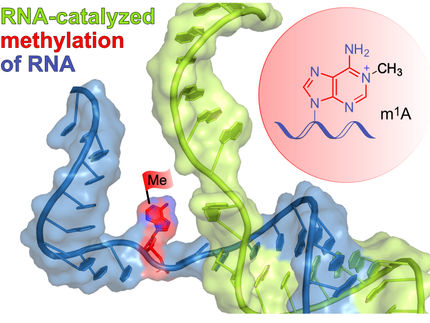New ribozyme can make RNA molecules accessible for click chemistry in living cells
Important progress for RNA research
Advertisement
A team led by Würzburg chemistry professor Claudia Höbartner has discovered a new ribozyme that can label RNA molecules in living cells.
RNA molecules are real all-rounders. They transfer the genetic information from the DNA in the cell. They regulate the activity of genes. And some of them have a catalytic effect: just like enzymes, they enable biochemical reactions that would be difficult or impossible to occur on their own. These special RNA molecules that accelerate such reactions are called ribozymes.
The team of chemistry professor Claudia Höbartner from Julius-Maximilians-Universität (JMU) Würzburg now presents a newly discovered ribozyme called SAMURI in the journal Nature Chemistry.
SAMURI can precisely modify other RNA molecules. This ability is very helpful for RNA research: "We can use such ribozymes as tools to label RNA with dyes and make it visible," says JMU researcher Dr. Takumi Okuda. "In this way, the pathways of RNA in the cell and its interactions with other molecules can be studied even better."
Ribozymes may also be considered for therapeutic use in the future. "We see new possible applications for ribozymes when the enzymes responsible for a specific task are missing or are no longer functional due to mutations," says Claudia Höbartner.
Details about the new ribozyme
What distinguishes the new ribozyme SAMURI? It modifies other RNA molecules at a precisely defined site of a specific adenine. There it attaches molecules to which, in turn, dyes or other molecules can easily be clicked in – like buckling up a seat belt. Such reactions are known as click chemistry.
SAMURI also has the advantage that it is active under the same physiological conditions that prevail in living cells. This is not the case with other synthetic ribozymes.
Another special feature: SAMURI uses a new synthetic cofactor to make RNA molecules accessible for click chemistry. This cofactor was developed by Dr. Takumi Okuda; it was inspired by the ubiquitous natural cofactor SAM (S-adenosylmethionine). This is also where the name of the new ribozyme comes from: SAMURI stands for "SAM-analogue utilising ribozyme".
The following steps in research
Claudia Höbartner's group next wants to elucidate the structure and mechanism of action of SAMURI. She also wants to develop further ribozymes that can modify RNA building blocks other than adenine.

















































